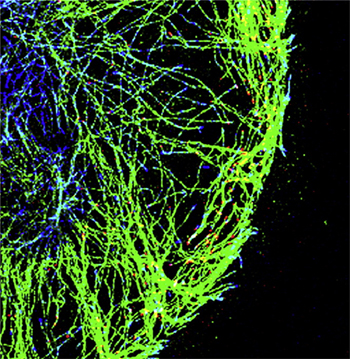| RIKEN Center for Developmental Biology (CDB) 2-2-3 Minatojima minamimachi, Chuo-ku, Kobe 650-0047, Japan |
December 9, 2008 – Microtubules are long polymer strands with functionally distinct plus- and minus-ends that function in a wide range of processes from morphogenesis to the shuttling of motor proteins through the cytoplasm. While many microtubules are anchored by their minus-ends to the centrosome, in epithelial cells some microtubules have non-centrosomal minus-ends, whose termination site has remained a mystery. New research by Wenxiang Meng and others in the Laboratory for Cell Adhesion and Tissue Patterning (Masatoshi Takeichi; Group Director) now reveals an important role for microtubules in the formation and maintenance of the zonula adherens, a lateral region in epithelial cells in which cell-cell adhesion proteins, such as cadherins, are highly concentrated. In an article published in Cell, Meng and colleagues identify a pair of novel proteins, PLEKHA7 and Nezha, which are involved in recruiting and dynamically anchoring the microtubules to the cadherin machinery.
The study began with a search for proteins that associate with p120 catenin, one of the cytoplasmic factors that binds to the cadherin tail in the cell’s interior. PLEKHA7 emerged from a pulldown assay for p120 catenin binding partners, and on immunostaining, the group found that the protein localized at cell-cell junctions in a p120 catenin-dependent manner. Testing for function, they found that overexpression of PLEKHA7 caused greater amounts of cadherin to accumulate at the zonula adherens, while its depletion by siRNA had the opposite effect. The group next looked for other proteins that might interact with PLEKHA7 in a new pulldown assay, and came up with a second unknown protein, which they dubbed Nezha, after a god who appears in the Chinese adventure “Journey to the West." Immunofluorescence-tagged Nezha showed that it co-localizes with PLEKHA7 at the zonula adherens in a co-dependent fashion. Overexpression of Nezha in cultured cells highlighted a role in microtubule bundling, prompting Meng et al. to look more deeply into this interaction. Double-immunostaining of Nezha and microtubules revealed a tendency for Nezha to associate with the minus-ends, a relative rarity in contrast to the many proteins that interact with microtubule plus-ends. A capping experiment using chemically tagged Nezha confirmed the association between this protein and microtubule minus-ends. Wanting to know more about the dynamics of the Nezha/minus-end interaction in living cells, Meng watched the behavior of fluorescence-labeled Nezha and ?-tubulin using time-lapse microscopy. He found that Nezha formed concentrated points from which single microtubule strands emerged and retracted, suggesting it was serving as a kind of anchor. These Nezha-microtubule complexes were themselves situated in PLEKHA7-positive regions in the zonula adherens, lending further weight to a functional relationship among these players. In addition to the roles in dynamically stabilizing cell structure, microtubules serve an important as tracks for motor proteins moving through the cytoplasm. Thinking that Nezha might tether microtubules to provide a route for minus-end-directed motor proteins to the cell junction, Meng tested a number of such candidates and found that the minus-end-directed protein KIFC3 was indeed localized at the zonula adherens. Loss-of-function experiments showed that its role there was important, as KIFC3 knockdown resulted in disorganization of E-cadherin in this zone. When the group interfered with microtubule polymerization in these cells using an inhibitor, the junctional localization of KIFC3 gradually faded before disappearing altogether, suggesting that PLEKHA7, Nezha, KIFC3 and microtubule minus-ends work together in maintaining zonula adherens integrity, which is essential for preserving the typical epithelial morphology of these cells. “The minus-end specificity of Nezha is an intriguing discovery,” says Meng. “It’s going to be exciting to learn more about how this PLEKHA7/Nezha/KIFC3 system relates to the processes of embryogenesis and proliferation and invasion in cancers.” |
||||||
|
||||||
 |
| Copyright (C) CENTER FOR DEVELOPMENTAL BIOLOGY All rights reserved. |
